It can be difficult to stick to a keto diet, but it's even harder if you don't have any quick and easy recipes for low-carb foods. Ramen noodles are the perfect diet fill-in for days you don't want to spend a lot of time in the kitchen.
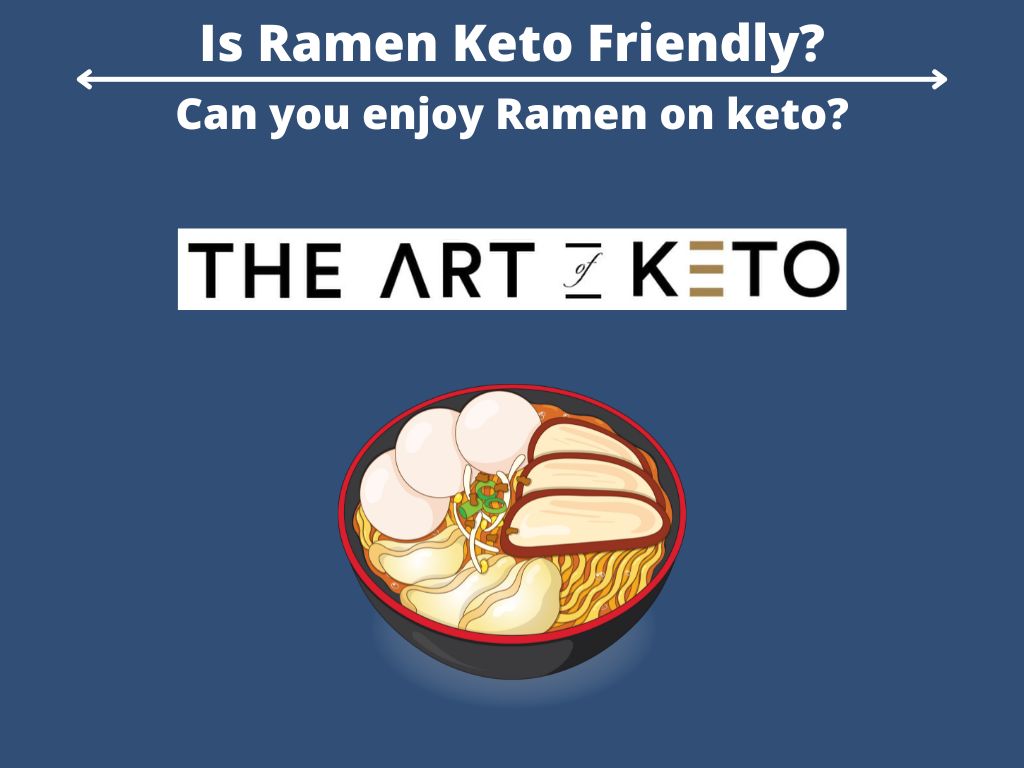
However, is ramen keto? Ramen is loaded with protein and whole grains that are very healthy on keto but may contain a lot of carbs for a keto diet. However, there's a trick to making the perfect low-carb ramen. Keep reading to find out how you can add ramen to your keto meals!
What is Ramen?
Traditional ramen is a Japanese dish that consists of Chinese-style wheat noodles served in a meat or fish-based broth, often flavored with soy sauce or miso, and topped with ingredients such as sliced pork, dried seaweed, and green onions.
Some variations may also include ingredients such as soft-boiled eggs, bean sprouts, and bamboo shoots.
Nutritional Value of Ramen
A typical serving of ramen (about one bowl) can vary in nutritional value depending on the ingredients and preparation methods used. However, a rough breakdown of the nutritional content of some common ingredients in traditional ramen dishes is as follows:
- Noodles (wheat-based): Approximately 200 calories per 100 grams, with a high carbohydrate content and small amounts of protein and fat.
- Pork: Approximately 275 calories per 100 grams, with high protein content and moderate amounts of fat.
- Broth (chicken or pork-based): Approximately 20-40 calories per 100 milliliters, with small amounts of protein, fat, and carbohydrates.
- Soy sauce: Approximately ten calories per tablespoon, with small amounts of protein, fat, and carbohydrates.
- Miso paste: Approximately 33.7 calories per tablespoon, with small amounts of protein, fat, and carbohydrates.
It's important to note that nutritional information can vary depending on the brand and preparation method.
Is Ramen Keto Friendly?
Ramen, as traditionally made, is not considered keto-friendly as it contains a high amount of carbohydrates from wheat-based noodles. A typical serving of ramen (about one bowl) can contain around 40-80 grams of carbohydrates, which is a significant portion of the daily carbohydrate intake on a ketogenic diet.
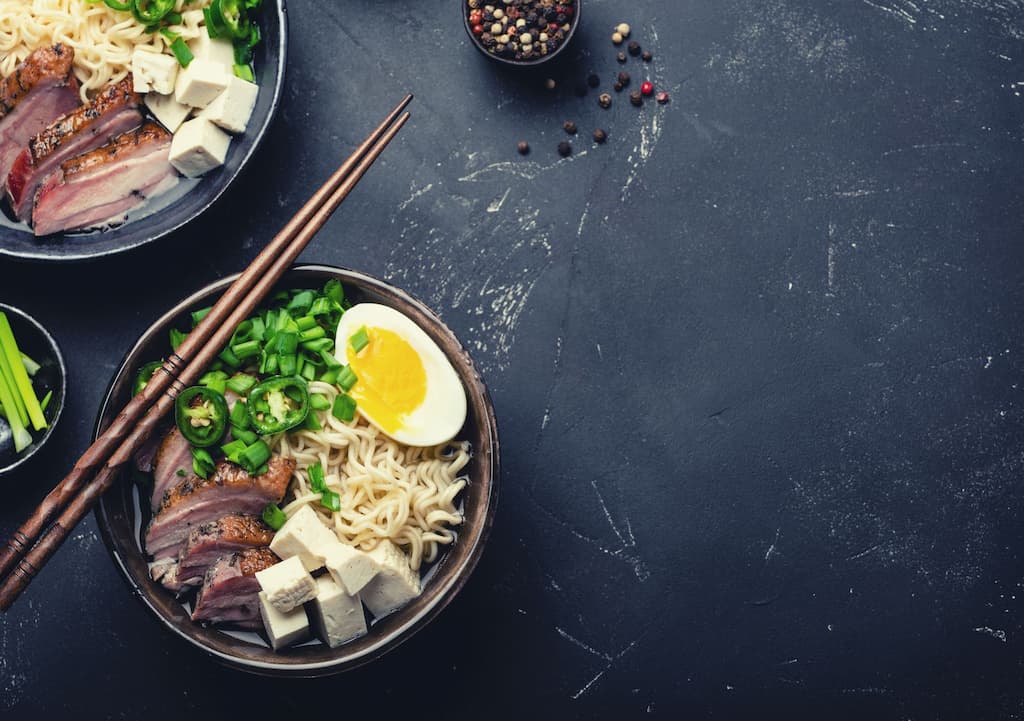
As for protein, a typical serving of ramen can contain around 10-20 grams of protein, depending on the ingredients used. The protein content comes mainly from the pork but also from the broth and the egg.
It's important to note that nutritional information can vary depending on the brand and preparation method; also, the nutritional needs of an individual vary depending on their activity level, body composition, and other factors. It's always a good idea to consult a healthcare professional for personalized nutrition advice.
Keto Friendly Ramen Ingredients
Here are a few keto-friendly ingredients that can be used in place of traditional ramen noodles:
- Zucchini noodles
- Shirataki noodles
- Kelp noodles
- Cabbage noodles
- Spaghetti squash
As for low-carb and high-fat protein options for ramen, here are a few suggestions:
- Pork belly
- Chicken thighs
- Beef brisket
- Shrimp
- Soft-boiled eggs
- Tofu (Fried in sesame oil)
You can also add some healthy fats like sesame oil, avocado oil, and coconut aminos to enhance the flavor and maintain the ketogenic ratio.
Keto Ramen Recipe Ideas
First things first: there's no magic formula for how to make good low-carb ramen. You'll have to experiment to find your favorite flavor combinations and figure out what works best for you. Here are some ideas to get you started!
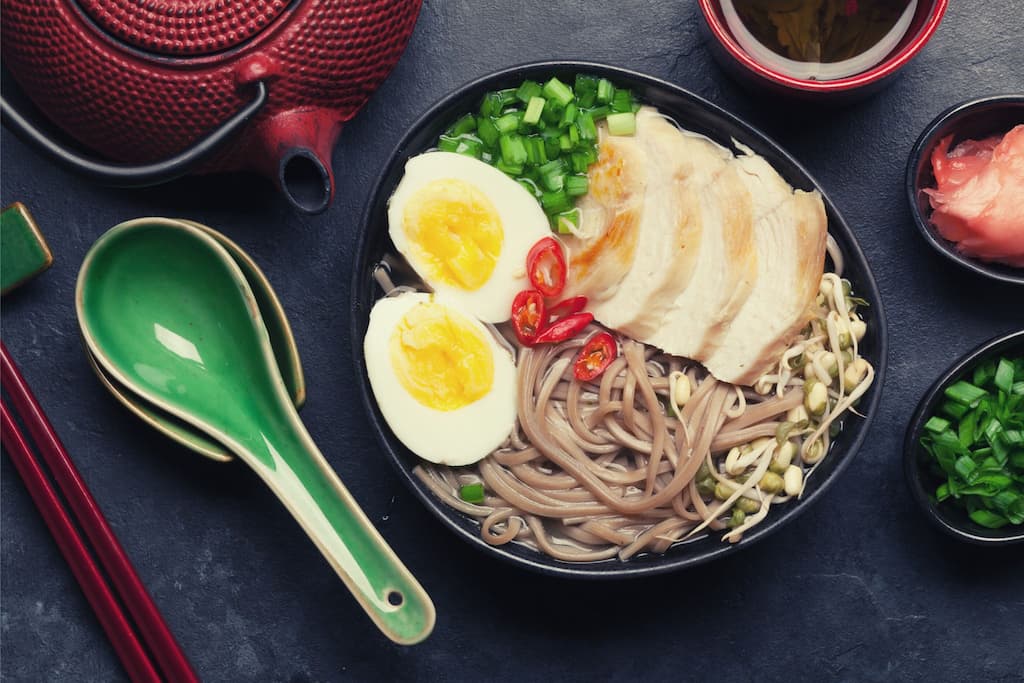
- Try gluten-free noodles to make a noodle dish that's both gluten-free and keto-friendly.
- Create a spicy Asian-style ramen dish using ginger, garlic, soy sauce, chili paste, sesame oil, and bean sprouts.
- Make Thai-inspired ramen by combining lemongrass, fish sauce, coconut milk, lime juice, and crushed peanuts.
- Combine ground beef or chicken with sour cream or cream cheese in a slow cooker for an easy beef stroganoff-like soup.
- Cook shredded cabbage or other vegetables in a pot of boiling water, and add plenty of salt and lemon juice at the end for a crunchy side dish!
You shouldn’t rely on pasta dishes to keep you full on a ketogenic diet because these foods are high in carbohydrates. You can enjoy keto-friendly ramen once in a while, but regularly consuming this carb-based food might kick you out of ketosis!
Tips for adjusting traditional ramen recipes to make them keto compliant
-You should cut the carbs by at least half. Traditional ramen is made with dried egg noodles, which are high in carbs. Egg noodles are also high in gluten. You should look for gluten-free noodles if you've been diagnosed with celiac disease or non-celiac gluten sensitivity.
-You can use other types of protein in place of meat in your recipe. Instead of ground beef, try adding cooked beans, mushrooms, edamame, tofu, or extra veggies to the broth for added protein.
-Use low-carb swaps to cut down on the carbs in your meal. You can use butter instead of oil, brown instead of white rice, cauliflower instead of rice, and spaghetti squash instead of regular pasta. The possibilities are endless!
-Try reducing the amount of sodium in your recipe. Most ramen seasoning packets contain a lot of salt. Also keep in mind that some seasoning packets also contain MSG. Skip the packet and use a combination of soy sauce, tamari sauce, and a little bit of salt instead.
These tips will help you make healthy keto meals that taste delicious!
Restaurants that Serve Keto Ramen
Japan is home to many different ramen restaurants, with over 10,000 of these in Tokyo alone! And the amount of new ramen places opening every year only keeps growing. There's no shortage of places that sell delicious keto-friendly ramen in Japan.
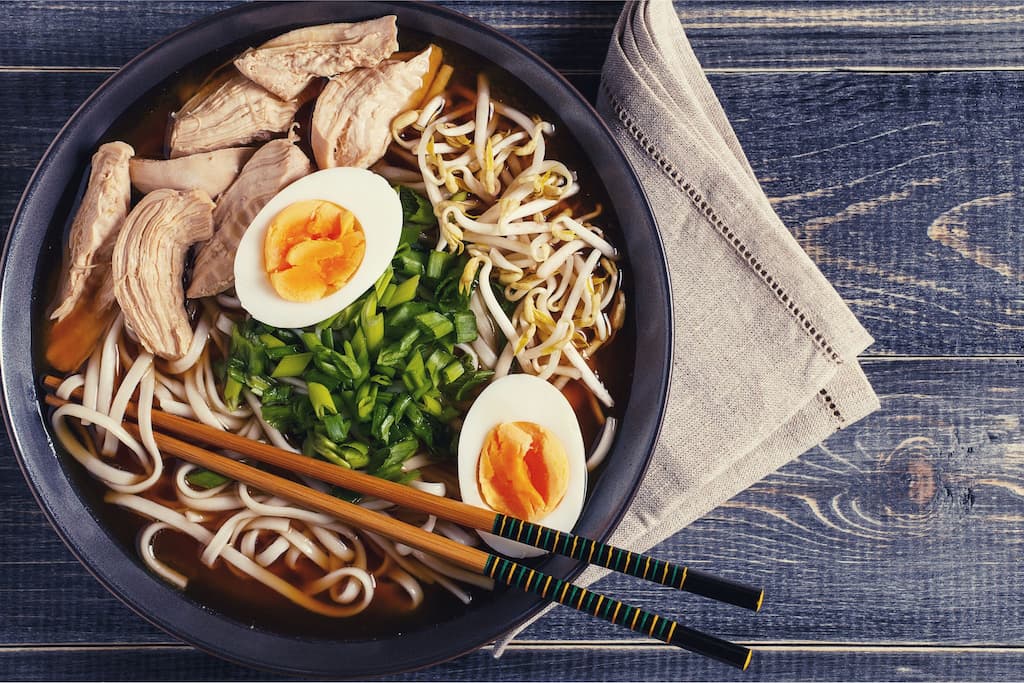
Some of the best are Ichiran, Ramen Hakata, and Do • Miso, and Hidakaya in Tokyo's bustling Minato city. In Kyoto, you can try the Ramen Factory in Minamiiseyachō, Kamigyo Ward.
When ordering ramen at a restaurant while following the keto diet, there are a few things to keep in mind.
- Choose broth-based soups: Ramen broth is typically made from pork or chicken, both of which are keto-friendly. Avoid creamy broths like miso or curry, as they contain added carbs.
- Add low-carb vegetables: Vegetables like bok choy, mushrooms, and green onions are great additions to ramen and are low in carbs.
- Ask for no or fewer noodles: Ramen noodles are high in carbs, so it is better to ask for no or fewer noodles. You can replace it with zucchini noodles or shirataki noodles.
- Watch the sauces: Many ramen dishes include soy sauce, which can add a lot of hidden carbs. Ask for the sauce on the side and use it sparingly or ask for a low-carb alternative.
- Check the protein: Some ramen dishes may include high-carb proteins like tempura shrimp or sweetened meats. Ask for grilled or plain meat instead.
It's always better to ask restaurant staff if they have any keto-friendly options or if they can make any adjustments to the menu items to fit your dietary needs.
Keto Friendly Alternatives to Traditional Ramen Noodles
There are several keto friendly alternatives to traditional wheat-based ramen noodles that can be used to make a low carb version of the dish:
- Zucchini noodles (also known as “zoodles”): These can be made by spiralizing zucchini, and have a similar texture to traditional ramen noodles. They are low in carbohydrates and calories and add a nice freshness to the dish.
- Shirataki noodles: These are made from konjac root and have a very low carbohydrate content. They can be found in different forms, such as fettuccine or spaghetti. They tend to have a bit of a rubbery texture but can be softened by rinsing, boiling, and frying them before adding them to the dish.
- Kelp noodles: Made from kelp and water, these noodles are low in calories and carbohydrates and add a nice mineral taste to the dish.
- Cabbage noodles: You can also use finely shredded cabbage as a noodle alternative. It's low in calories, and carbohydrates and can be cooked quickly.
- Spaghetti Squash: A naturally low-carb and gluten-free alternative, spaghetti squash can be spiralized or cut into thin strips to mimic the texture of traditional ramen noodles.
It's important to note that while these alternatives are lower in carbohydrates than traditional wheat-based ramen noodles, the nutritional content of the dish will still depend on the ingredients and preparation methods used.
How to Make Keto Ramen at Home
Here is a step-by-step guide for making keto friendly ramen at home:
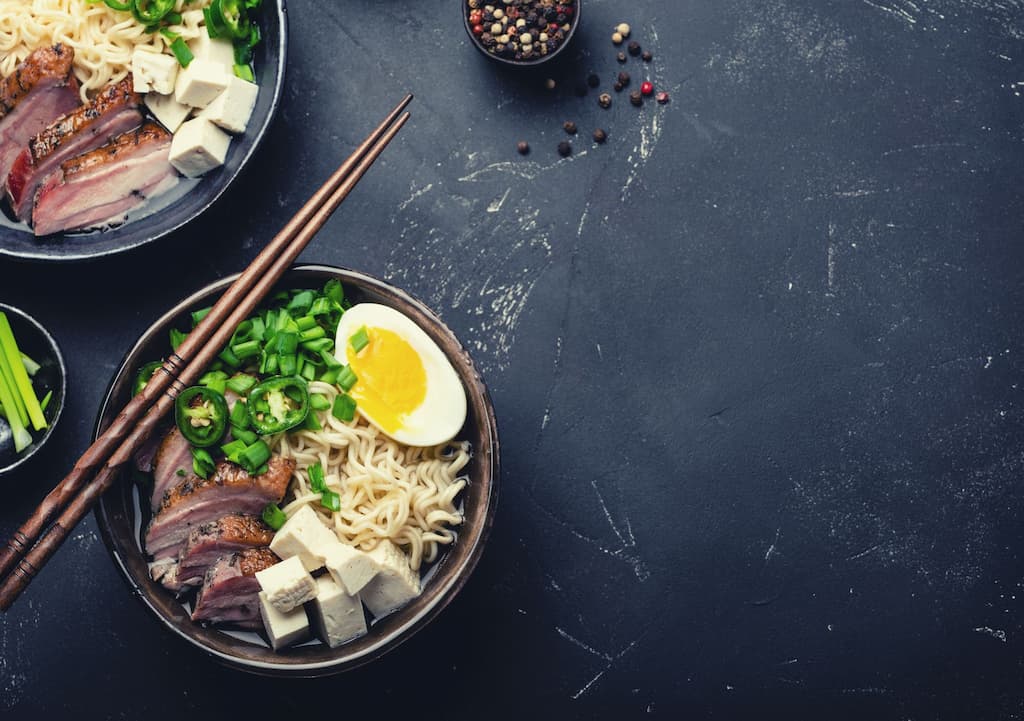
- Make the broth: In a large pot, bring chicken or beef stock to a boil. Add in aromatics like ginger, garlic, and green onions for flavor. Reduce the heat and let simmer for at least 30 minutes.
- Prepare the noodles: There are a few options for keto friendly noodles, such as shirataki noodles or zucchini noodles. To make zucchini noodles, use a spiralizer or a mandoline to create thin noodles. To prepare shirataki noodles, rinse them thoroughly and boil them for a few minutes to remove any odors.
- Cook the protein: While the broth is simmering, cook your protein of choice (such as chicken, beef, or pork) in a separate pan. Cut the protein into thin slices or bite-sized pieces.
- Add vegetables: Add low-carb vegetables like bok choy, mushrooms, and green onions to the broth and let them cook for a few minutes.
- Assemble the ramen: In a bowl, place the cooked noodles at the bottom, followed by the cooked protein, and then ladle the broth and vegetables over the top.
- Add toppings: Some keto friendly toppings include sesame seeds, green onions, and a soft-boiled egg.
For sourcing ingredients, you can find shirataki noodles and other keto friendly products at health food stores or online. For equipment, you will need a large pot, a spiralizer or mandoline (if using zucchini noodles), and a pan for cooking the protein.
Keep in mind that it's always better to check the nutrition information of ingredients and sauces to make sure they fit your dietary needs.
Conclusion
Traditional ramen noodles are not considered keto-friendly as they are made from wheat flour and are high in carbohydrates. However, there are alternative low-carb or keto-friendly noodles that can be used to make ramen, such as shirataki noodles, zucchini noodles, or kelp noodles.
Additionally, you can adjust the toppings and ingredients to make it more keto-compliant by using more protein, healthy fats, and low-carb vegetables.
The keto diet is the best way to lose weight and start a healthy lifestyle. It focuses on eating whole foods that are low in carbs and high in fats and protein. There are several types of foods you can eat on the keto diet, including meat, fish, eggs, dairy, nuts, seeds, and healthy oils.
Ramen may not be the best food to eat on keto, but you can enjoy its keto-friendly version using the recipe above. The key to reaping the benefits of keto is sticking to it religiously. It will be hard, but with the right mindset, you can do it!
If you'd like to learn more about keto friendly foods, please click on one of the links below:
Is Shrimp Cocktail Keto Friendly?
Are Cherry Tomatoes Keto Friendly?
Frequently Asked Questions on Ramen and Keto Diet
Can you eat ramen noodles on a keto diet?
No, traditional ramen noodles are high in carbohydrates and would not be suitable for a ketogenic diet.
Why is Ramen so high in carbs?
Ramen noodles are high in carbohydrates because they are made primarily from wheat flour.
Can Ramen help you lose weight?
Ramen can be part of a weight loss diet if consumed in moderation and as part of a balanced diet that includes plenty of fruits and vegetables. However, traditional ramen noodles are high in calories and sodium, so it is important to be mindful of portion sizes and to choose lower-calorie and lower-sodium options when possible.
How to make Ramen healthier?
To make ramen healthier, use less oil, less salt, and less soy sauce. Add more vegetables and lean proteins, such as chicken, tofu, or shrimp. Also, you can use whole wheat or rice noodles instead of traditional ramen noodles.
How do you increase protein in Ramen?
To increase protein in Ramen, add more protein-rich ingredients such as chicken, beef, pork, shrimp, tofu, or eggs. You can also add additional protein-rich toppings like seeds, nuts, or legumes like edamame, peas, or lentils.
Is Ramen good for every day?
Eating Ramen every day is not recommended as it is high in sodium and calories and may lack essential nutrients. It is best consumed in moderation as part of a balanced diet that includes a variety of fruits, vegetables, lean proteins, and whole grains.
